Menus
- Italian classic
- Where is progress in the sign of the eagle??
- Technical data – Moto Guzzi V7 Cafe Classic
- Noticed
- Moto Guzzi Nevada 750 – The Follower
- Moto Guzzi Griso 8V SE – Another caliber
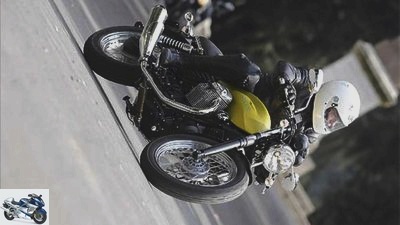
Moto Guzzi
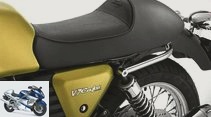
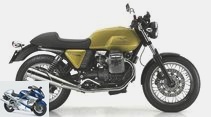
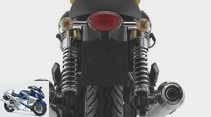
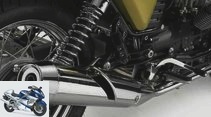
7th photos
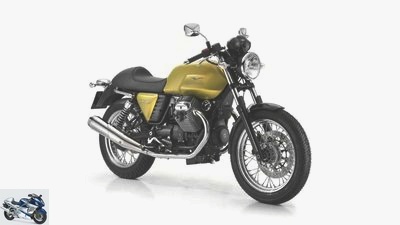
Moto Guzzi
1/7
Moto Guzzi V7 Cafe Classic.
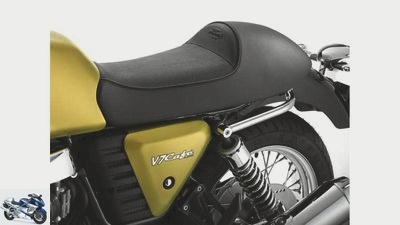
Moto Guzzi
2/7
Moto Guzzi V7 Cafe Classic.
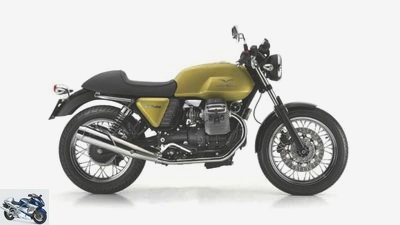
Moto Guzzi
3/7
Moto Guzzi V7 Cafe Classic.
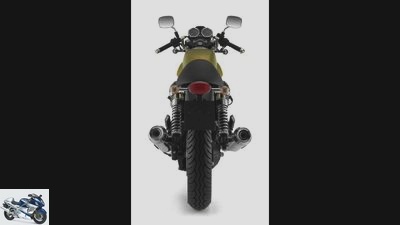
Moto Guzzi
4/7
Moto Guzzi V7 Cafe Classic.
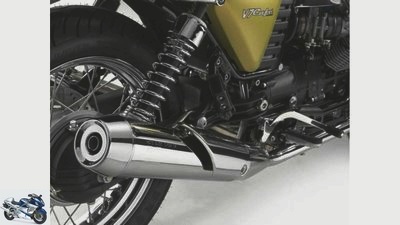
Moto Guzzi
5/7
Moto Guzzi V7 Cafe Classic.
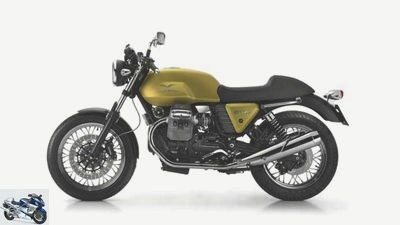
Moto Guzzi
6/7
Moto Guzzi V7 Cafe Classic.
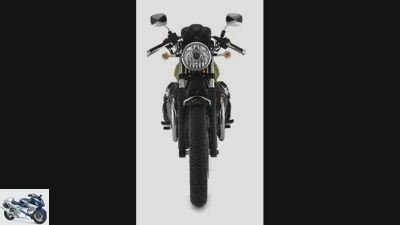
Moto Guzzi
7/7
Moto Guzzi V7 Cafe Classic.
Driving report Moto Guzzi V7 Cafe Classic
Italian classic
Two hours of driving time and a full 23 kilometers of city traffic in Rome for three new Moto Guzzi models. Everything had started so well …
Monday morning. Call from Moto Guzzi in the editorial office: Time and energy to check out the new V7 Cafe Classic in Rome? Also the renovated 750 sister Nevada and the special edition of the Griso 8V? Yeah yeah It fits perfectly: Rome, Eternal City. 90-degree V2, eternal and for a long time the only drive concept at Guzzi: air-cooled, the cylinders exposed and yet towering in the airstream. Great. And then the name. V7 Cafe Classic. Sounds like a well-foamed cappuccino smells like.
In any case, it looks delicious at first glance, the new one. The matte, yellow-green paint boldly cites the legendary V7 Sport from 1972. How seductive stubby handlebars, lush hump seat and moderately high mufflers look? to list the only technical differences to the V7 Classic presented in 2008. Otherwise everything stayed the same. Or better: with the new that makes you look old. The two sisters share the frame, tires, spoked wheels and spring elements as well as the 17 liter plastic tank and the 744 cm³ two-cylinder with cardan drive. Yes, the Italians have a feel for style and shapes, everything is right. At least viewed from a few meters away. The good impression doesn’t quite hold up when you come up close, get in touch. A lot of red pencil has ruled the construction of the Cafe Classic. The cheapest components of the European supplier industry are installed here. The reach of both hand levers is not adjustable. Luminaires like fenders made of plastic, heaps of chrome-plated plastic and crumpled weld seams look cheap and rustic. Is this still a pre-series or already the final series standard?
Moto Guzzi
The line is right, lean and slim, the workmanship should be better.
Badly deburred plastic parts, especially with these really beautiful side covers, also indicate poor workmanship. With their horizontal rows of lattices, they are also one-to-one from the “Classic”. And thus cite the original V7 from 1967, conceptually the original mother of all Guzzis today. But the Cafe Classic is supposed to be a homage to the legendary V7 Sport. And it had side covers made up of three triangles. The way they are indicated in color here and today. Doesn’t matter anyway. Because the Sport, which was built from 1972 to 1974, broke the magical limit of 200 km / h with standard 62 hp. The proud 750 was one of the fastest motorcycles in the world at the time. It also had a chassis that was far superior to that of the most potent Japanese. These footsteps are several sizes too big for the successor three and a half decades later. With almost the same displacement as it used to be, it delivers a modest 48 hp, with injection and lambda probe. The 91 hp V11 Sport was more authentic in 1999.
Where is progress in the sign of the eagle??
Long lying there today would be maybe 170 things. But how do you know? Moto Guzzi’s parent company Piaggio has decided not to leave Rome at all during the presentation of the new models. That has also proven itself at similar events with scooters … Hmm. The sometimes bustling, sometimes anarchist traffic demands almost all of your concentration: Don’t let yourself be pushed away, keep an eye on the man in front and don’t lose the man behind. Go then! The Small-Block-V2 lets its horses go smoothly and flexibly. It’s okay, the drive in the purely urban jungle. The 750 sounds sonorous enough. She snorkels in the air with a throaty snorkel, and puffs out the exhaust fumes in a pleasant, muffled manner. In terms of sound, the small one is a big one. Only turning the twin out of the way is out of the question, and we never get beyond third, maybe fourth gear. The shift travel is long, the shift feel is doughy. After all, the five speed steps rest more precisely than in the 1970s. The clutch can be pulled as soft as butter. Always nice: How every Moto Guzzi first leans to the right when the accelerator is idle, then to the left and finally back to the middle position. Everything is due to the back torque of the crankshaft rotating across the direction of travel. Something dances, stamps and lives beneath you.
According to the factory, the ready-to-drive machine, weighing 198 kilograms, is wonderfully easy to steer around the Fiats, orbits pirouettes around large trucks and clumsy tourists. Narrow tires like back then promote easy handling. 100 millimeters at the front, 130 at the back. At least contemporary on 17-inch wheels. 18-inchers were yesterday. And apparently the rather short wheelbase (1449 millimeters) compensates for the rather flat steering head angle (62.5 degrees). The brakes have a slight play, after all a Brembo four-piston caliper bites the single disc at the front. 40 mm Marzocchi fork and Sachs spring struts are comfortably matched. Because even in Italy’s capital there are rough potholes and frost cracks. When trying to take it a little sportier, the soft spring elements seem to lack damping reserves. The Brazilian Metzeler Lasertec tires only stick very modestly. Bridgestone BT 45 would probably be a better choice. The sitting position fits. Not half as sporty as the handlebars first suggested. You don’t bend too low over the extremely narrow tank. The fat hump and the missing pillion pegs thwart pillion operation. The German importer is considering delivering the latter, including a two-person bench, as a bonus when buying it for € 8,500.
The first photo stop in the middle of the metropolis is completely unsuitable, the Italians break off the action. ??Too much traffic.?? The location was probably an insider tip yesterday. Don’t think about it any further … Try again. Not a real curve, more like a kind of kinking right of way on one of the hills of Rome. But it works, finally the photographer can take action, see opening photo. Now quickly switched to the available Nevada and Griso SE. But soon the bustle ends. After two hours of driving and 23 kilometers, it’s time to get to the plane. Wait, first the DVD with the photos! Such a suggestion surprised the Guzzi people a little. Are you waiting for that? But then it still works somehow. According to an old joke, in Europe heaven is where Italians are the lovers, hell is where they organize. Maybe there is something to it, this Cafe Racer off the peg, the Cafe Classic, has what it takes to be a heartbreaker.
Technical data – Moto Guzzi V7 Cafe Classic
Moto Guzzi
engine
Air-cooled two-cylinder four-stroke 90-degree V-engine, a chain-driven camshaft below, two valves per cylinder, bucket tappets, bumpers, rocker arms, wet sump lubrication, injection, ø 36 mm, regulated catalytic converter, 330 W alternator, 12 V battery / 14 Ah, mechanically operated single-plate dry clutch, five-speed gearbox, cardan, secondary ratio 4.825.
Bore x stroke 80.0 x 74.0 mm
Displacement 744 cm³
Compression ratio 9.6: 1
Rated output 35.5 kW (48 hp) at 6800 rpm
Max. Torque 55 Nm at 3600 rpm
landing gear
Double loop frame made of steel, telescopic fork, ø 40 mm, two-arm swing arm made of steel, two spring struts, adjustable spring base, front disc brake, ø 320 mm, four-piston fixed caliper, rear disc brake, ø 260 mm, two-piston fixed caliper.
Spoked wheels with steel rims 2.50 x 18; 3.50 x 17
110/90 18 tires; 130/80 17
Dimensions + weights
Wheelbase 1449 mm, steering head angle 62.5 degrees, caster 109 mm, spring travel f / h 130/118 mm, seat height 805 mm, dry weight 182 kg, tank capacity / reserve 17.0 / 2.5 liters.
Two year guarantee
Color green
Price incl. 8500 euros
Noticed
positive
+ Sound just a nice sound
+ Design elegant retro styling
+ Predictable performance development
+ Beginner-friendly, optional 34 hp version
+ Handling / weight easy to drive, easy
negative
– Processing moderate
– Transmission long shift travel
– Performance poor due to low power
– Everyday suitability with a one-man hump is low
Moto Guzzi Nevada 750 – The Follower
Yes, it still exists, even with a little facelift: The easy-to-drive Nevada holds up the soft chopper flag at Guzzi.
Moto Guzzi
Soft chopper from Moto Guzzi: Nevada 750.
Don’t be fooled at first sight. The Nevada is clearly reminiscent of Japanese soft choppers from the 80s. A type of motorcycle that has justifiably disappeared into oblivion.
In any case, the insignia of the Italo bride are reminiscent of the Viragos and LTDs, Customs and Specials: embarrassing air scoops made of chrome-plated plastic, antler handlebars, step bench and indecisive seating position, for example. You sit somewhere between relaxed and wanted, but not able to. On the other hand, it even has something: The upright posture of the upper body is ideal for sightseeing tours, so the Nevada that is just part of the program carries Italian dolce vita with it. A motorcycle for people who just want a wheelchair, but for whom an even more practical large scooter has too little style or steam.
Now 48 hp and 55 Newton meters are a pretty modest yield for a 750. However, they only have to push around four hundredweight here, which is completely atypical for a chopper: Moto Guzzi mentions 198 kilograms as the ready-to-drive weight, including the not very voluminous 14-liter drop tank when fully filled. The Nevada rolls much livelier, more manageable and more predictable on its narrow tires than anything real heavy metal. A 110 / 90-18er rotates at the front, a 130 16-inch model at the rear. New for model year 2009: the exhaust system with the now deeply placed silencers. The end pots are a genome of the V7 Classic. The instruments are also modified. There are also new colors: In addition to the fashionable white shown, classic bordeaux red. The name suffix ?? Classic has been omitted, the price has been increased slightly to 8390 euros including additional costs.
Moto Guzzi Griso 8V SE – Another caliber
With a matt two-tone paint, spoked wheels and fine details, the Griso becomes a noble Special Edition.
Moto Guzzi
Heavy beefy and elegant, the Griso 8V SE embodies great Italian style.
Punch and postmodernism, these are the poles that the Moto Guzzi Griso 8V unites. Their “Quattro Valvole” heads with the BMW boxer-style raised camshafts that are not overhead allow higher speeds and more gas throughput than the antiquated two-valve engine before. A full 110 hp rated power is a word for the air-cooled racing car. The oil cooler sits to the right of the traditionally ribbed engine housing. There, where the martial, arm-thick stainless steel elbows nestle against one another on the left. The design of the rear silencer and the aluminum single-sided swing arm with torque support follows the design of a genuine muscle bike.
The stylish, well-made Griso 8V even advanced to become the best-selling model from Mandello in Germany. Now Guzzi is pushing the Special Edition after her. On the SE, matt green paint and beige trim contrast with plenty of black metal parts: the steel frame and engine housing are just as dark as the wide, butted handlebars or the instrument housing. The same applies to the 43 mm upside-down fork, the swing arm, and the aluminum rims from Excel. The latter hang on classic wire spokes. The mix of traditional and modern continues with the brown bench with different covers for the seat and side surfaces. At first glance it looks like real leather.
This composition of harmonious proportions and fine shapes is definitely aimed at the Harley clientele. The braking performance, however, is well above that of most American bikes: radially hinged Brembo fixed calipers delay the front. The clutch, which has to be pulled tight, and a combat weight of almost 250 kilograms require compromises in the city traffic of Rome. But the start is right. At least if you stay above or below the annoying torque hole between 3000 and 5000 tours. The Special Edition costs 13,900 euros, 600 euros more than the standard Griso.
Related articles
-
Driving report Moto Guzzi California Vintage
Gargolov Driving report Moto Guzzi California Vintage Saddle tractor Moto Guzzis with large, wide saddles have been known as California for 35 years. And…
-
Impression: Harley-Davidson Road King Classic and Moto Guzzi California Vintage
Artistic Impression: Harley-Davidson Road King Classic and Moto Guzzi California Vintage There’s only two directions here, boy! With two air-cooled …
-
Impression – Moto Guzzi California Touring, Indian Springfield and Harley-Davidson Road King Classic
bilski-fotografie.de Impression – Moto Guzzi California Touring, Indian Springfield and Harley-Davidson Road King Classic Westwards Two days free: …
-
Driving report Moto Guzzi Breva V 1100
fact Driving report Moto Guzzi Breva V 1100 Una Storia Italiana The story of the long-announced Moto Guzzi Breva V 1100 is a typically Italian one: of…
-
Moto Guzzi V85 in the driving report 2018
New items 2019 Top topic Alberto Cervetti / Motociclismo 19 pictures Alberto Cervetti / Motociclismo 1/19 The Italian colleagues from Motociclismo are the …
-
Driving report Cafe Racer My Generation Two machines that go to the heart because they revive the spirit of days long gone: the …
-
Moto Guzzi V7 III Special in the driving report
Wolfgang Spankowski 15 pictures Wolfgang Spankowski 1/15 Moto Guzzi V7 III Special. Wolfgang Spankowski 2/15 Moto Guzzi V7 III Stone: The V7 base model …
-
Driving report Moto Morini 1200 Granpasso
Nakamura Driving report Moto Morini 1200 Granpasso On the Passo, set, go In addition to Benelli TreK Amazonas and Moto Guzzi Stelvio, the Moto Morini…
-
Driving report Moto Guzzi V7 Classic
Moto Guzzi 3 photos Moto Guzzi 1/3 Moto Guzzi 2/3 Moto Guzzi 3/3 Driving report Moto Guzzi V7 Classic The magnificent seven It was the most famous Guzzi…
-
Driving report Moto Guzzi Griso 8V
Bilski Driving report Moto Guzzi Griso 8V With two game four Moto Guzzi traditionally relies on two cylinders. Classically air-cooled, lying lengthways,…